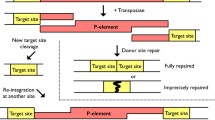Abstract
Clustered regularly interspaced short palindromic repeat is popularly known worldwide by its acronym CRISPR. It is a modern technique that has revolutionized molecular studies by its unique coherence in genome engineering. The robust nature and specificity of this novel approach in molecular biology have enabled researchers worldwide to adapt this method in various developmental studies. Drosophila melanogaster, the model organism which paved the path for groundbreaking discoveries in the field of developmental biology, is also one among many other such model systems in which the CRISPR-Cas9 system has been integrated. Despite there being other practices of mutagenesis available, the CRISPR-Cas9 system provides an edge over other such methods in terms of accuracy and efficiency, which ensures an expeditious screening process thereafter. Here we make an attempt to introduce the detailed protocol and essential steps therein involved in generating knockout allele mutants in Drosophila.
Access this chapter
Tax calculation will be finalised at checkout
Purchases are for personal use only
Similar content being viewed by others
References
Barrangou R, Fremaux C, Deveau H, Richards M, Boyaval P, Moineau S, Romero DA, Horvath P (2007) CRISPR provides acquired resistance against viruses in prokaryotes. Science 315(5819):1709–1712
Carte J, Christopher RT, Smith JT, Olson S, Barrangou R, Moineau S, Glover CV III, Graveley BR, Terns RM, Terns MP (2014) The three major types of CRISPR-Cas systems function independently in CRISPR RNA biogenesis in Streptococcus thermophilus. Mol Microbiol 93(1):98–112
Makarova KS, Haft DH, Barrangou R, Brouns SJ, Charpentier E, Horvath P, Moineau S, Mojica FJ, Wolf YI, Yakunin AF, Van Der Oost J (2011) Evolution and classification of the CRISPR–Cas systems. Nat Rev Microbiol 9(6):467
Jinek M, Jiang F, Taylor DW, Sternberg SH, Kaya E, Ma E, Anders C, Hauer M, Zhou K, Lin S, Kaplan M (2014) Structures of Cas9 endonucleases reveal RNA-mediated conformational activation. Science 343(6176):1247997
Nishimasu H, Ran FA, Hsu PD, Konermann S, Shehata SI, Dohmae N, Ishitani R, Zhang F, Nureki O (2014) Crystal structure of Cas9 in complex with guide RNA and target DNA. Cell 156(5):935–949
Port F, Chen HM, Lee T, Bullock SL (2014) Optimized CRISPR/Cas tools for efficient germline and somatic genome engineering in Drosophila. Proc Natl Acad Sci 111(29):E2967–E2976
Pastink A, Heemskerk E, Nivard MJ, van Vliet CJ, Vogel EW (1991) Mutational specificity of ethyl methanesulfonate in excision-repair-proficient and-deficient strains of Drosophila melanogaster. Mol Gen Genet MGG 229(2):213–218
Lin SC, Chang YY, Chan CC (2014) Strategies for gene disruption in Drosophila. Cell Biosci 4(1):63
Liao GC, Rehm EJ, Rubin GM (2000) Insertion site preferences of the P transposable element in Drosophila melanogaster. Proc Natl Acad Sci 97(7):3347–3351
Huang AM, Jay Rehm E, Rubin GM (2009) Quick preparation of genomic DNA from Drosophila. Cold Spring Harb Protoc 2009(4):pdb–prot5198
Author information
Authors and Affiliations
Corresponding author
Editor information
Editors and Affiliations
Rights and permissions
Copyright information
© 2020 Springer Science+Business Media, LLC, part of Springer Nature
About this protocol
Cite this protocol
Patnaik, A., Mishra, M. (2020). CRISPR Technique for Gene Deletions in Drosophila. In: Mishra, M. (eds) Fundamental Approaches to Screen Abnormalities in Drosophila. Springer Protocols Handbooks. Springer, New York, NY. https://doi.org/10.1007/978-1-4939-9756-5_15
Download citation
DOI: https://doi.org/10.1007/978-1-4939-9756-5_15
Published:
Publisher Name: Springer, New York, NY
Print ISBN: 978-1-4939-9755-8
Online ISBN: 978-1-4939-9756-5
eBook Packages: Springer Protocols




